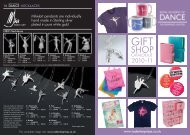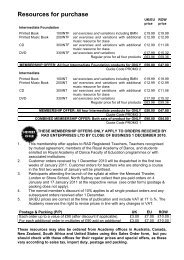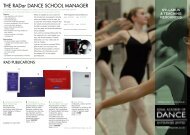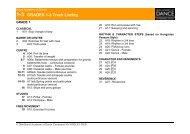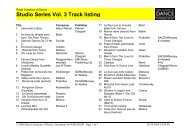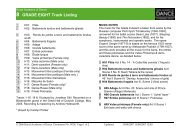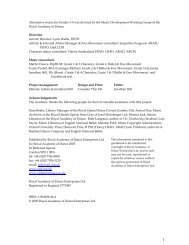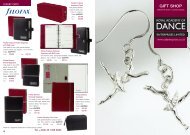Music in Focus guidebook to Alternative Music for Grades 1-3
Music in Focus guidebook to Alternative Music for Grades 1-3
Music in Focus guidebook to Alternative Music for Grades 1-3
You also want an ePaper? Increase the reach of your titles
YUMPU automatically turns print PDFs into web optimized ePapers that Google loves.
Guide <strong>to</strong> abbreviations and codes used <strong>in</strong> this book<br />
For the sake of brevity and ease of use, abbreviations are used throughout this<br />
book which are expla<strong>in</strong>ed <strong>in</strong> the table below.<br />
Number<strong>in</strong>g:<br />
Every exercise <strong>in</strong> <strong>Grades</strong> 1‐5 has been allocated a code that consists of two parts:<br />
i) a letter from A‐E, which corresponds <strong>to</strong> the Grade (A=Grade 1, B=Grade 2,<br />
C=Grade 3, D=Grade 4, E=Grade 5)<br />
ii) a number from 01‐99<br />
Example:<br />
A1= the first exercise <strong>in</strong> Grade 1, E10=the 10 th exercise <strong>in</strong> Grade 5.<br />
These code numbers are designed <strong>to</strong> m<strong>in</strong>imise confusion when discuss<strong>in</strong>g or<br />
referr<strong>in</strong>g <strong>to</strong> the music <strong>for</strong> a particular exercise. It is much simpler <strong>to</strong> say “B03”<br />
than “the battements tendus à la seconde and devant from 1 st <strong>in</strong> Grade 2 –<br />
presentation class only”. They will also help pianists who have little experience <strong>in</strong><br />
play<strong>in</strong>g <strong>for</strong> classes or <strong>for</strong> the RAD syllabus <strong>to</strong> locate the correct music <strong>in</strong> the event<br />
of a misunderstand<strong>in</strong>g.<br />
Songbook codes<br />
Throughout this book and the music scores, folk song collections are referred <strong>to</strong><br />
by abbreviations such as ‘GRS’ <strong>for</strong> The Gateway Russian Song Book, or PFD <strong>for</strong><br />
Polish Folk Dance, which are expla<strong>in</strong>ed <strong>in</strong> full <strong>in</strong> Appendix 3 ‘Song Collections<br />
Referred <strong>to</strong> <strong>in</strong> this Book’<br />
Intro: Introduction (the number of counts NOT bars).<br />
In pieces that are <strong>in</strong> a slow triple metre, “2 (6)” <strong>in</strong>dicates that the<br />
<strong>in</strong>troduction may feel like 6 rather than 2.<br />
Title: Title of the music used <strong>for</strong> the exercise<br />
[arr] be<strong>for</strong>e the title means that the music is an arrangement of the<br />
orig<strong>in</strong>al work, with cuts or additions<br />
Composer: Composer of the piece used<br />
Ballet: Ballet from which the music came (if applicable)<br />
[SD] Stage Direction (<strong>in</strong> the pr<strong>in</strong>ted score)<br />
Chor.: Choreographer of the ballet from which the music comes<br />
TS Time signature of the alternative music used. The figure <strong>in</strong> brackets<br />
is the time signature of the first syllabus music.<br />
R: Rhythmic pattern or dance rhythm of the music used<br />
P Presentation class only<br />
2



